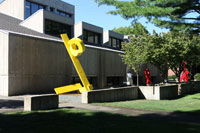 For the first time, at least in “modern” history, students can pursue any and all of Milton’s visual arts programs in one building, the Art and Media Center. This summer, changes that will not strike some as dramatic, have nevertheless prepared all three levels of the AMC for unparalleled opportunities and collaborations in the arts. Ian Torney, visual arts chair, used the relocation of sculpture, ceramics and woodworking from Robert Saltonstall as a chance to rethink how spaces are outfitted and aligned, not only for today’s world of arts, but anticipating how the field will develop over time.
For the first time, at least in “modern” history, students can pursue any and all of Milton’s visual arts programs in one building, the Art and Media Center. This summer, changes that will not strike some as dramatic, have nevertheless prepared all three levels of the AMC for unparalleled opportunities and collaborations in the arts. Ian Torney, visual arts chair, used the relocation of sculpture, ceramics and woodworking from Robert Saltonstall as a chance to rethink how spaces are outfitted and aligned, not only for today’s world of arts, but anticipating how the field will develop over time.
The two studios on the AMC’s south side are now all dedicated to 3-D art, including sculpture and ceramics. The two north-facing studios will serve drawing, painting and printmaking. All four main level studios are flexible enough to support any studio art foundations course. A new machine tool shop located in the center now connects both banks of studios, making projects of all kinds possible as contemporary art-making blurs the lines between two- and three-dimensional arts. The building’s loading dock now has electrical power to accommodate outdoor welding, and electrical outlets hang from the ceilings in various locations throughout all the studios. New Smartboards in all four main level studios support teaching.
On the AMC’s top floor, the former Weld Library has become a technology and design studio; Bryan Cheney (Visual Arts) and Brad Moriarity (Science) teach their new collaborative course in this studio, Creating Form and Space: Architecture and Engineering. A digital imaging MAC lab is located on the west side of the top level, along with a lighting studio for photography. The east side of that level features a MAC moving image lab and viewing studio.
Not to be left out of the action, the AMC lower level now includes an office and work space for Milton’s busy A/V department, and a film and moving image production studio, with a “green screen,” a prerequisite for shots that involve actors and imposed imagery (like the meteorologist broadcasting a weather forecast in front of a relevant map). The AMC lower level also provides dedicated space for robotics and computer engineering projects, in addition to Greely Auditorium, the Nesto Gallery, and photography dark room facilities. Key upgrades to make the building accessible to persons with disabilities have occurred as well.
This upgrade and rework of AMC space looks to maximize capability and functional ease for all types of imaginative projects that students and faculty typically devise. Classrooms are flexible; technology, which “is one of the key drivers in visual arts growth,” according to Ian, is ubiquitous. “We haven’t precluded doing more in and for the arts,” he says, “and the enhancements in this building are not only effective today; they look quite deliberately to a future that we regularly work to anticipate.”
Note: RSG vacated spaces now accommodate two classrooms for Milton’s health, fitness and wellness programs, and create needed meeting, office and storage space for Athletics.